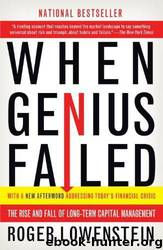When Genius Failed: The Rise and Fall of Long-Term Capital Management by Lowenstein Roger

Author:Lowenstein, Roger [Lowenstein, Roger]
Language: eng
Format: mobi
Tags: Business
Publisher: Random House
Published: 2001-01-17T16:00:00+00:00
In the first months of 1998, markets were smooth. The International Monetary Fund worked out a bailout of South Korea, capping a stabilizing trend in Asia. In Europe, where the launch of the euro was less than a year away, investors were bathing in a spirit of optimism. In the United States, the Dow broke into record territory. As investors regained confidence, bond spreads narrowed. At the start of 1998, A-rated bonds (those issued by strong corporations, such as Ford Motor) yielded 75 basis points more than Treasurys; by February, the spread had narrowed to 70 points.
Such balmy currents, though apparently unrelated, reflected a generalized feeling that the crisis of the previous fall had passed even though a certain edginess lingered. In October 1997, after the debacle in Asia, Merrill Lynch had ordered its bond traders to downsize their positions. They had in fact pulled back, but by the beginning of 1998 they were reverting to business as usual. The world had gotten past so many crises; it had seen the United States and the IMF rescue Mexico, Thailand, Korea. “No one believed that Asia would spread,” noted Dan Napoli, Merrill’s risk manager, referring to the traders who put the firm’s capital on the line. As such sanguine attitudes percolated up from the trading desk of bank after bank, credit spreads inevitably narrowed.
The mood at Long-Term was relaxed, too. Though the fund’s leverage was up, and though the partners had taken out huge personal loans, their exposure seemed tolerable. According to one estimate, Hilibrand alone was worth half a billion dollars and Meriwether was in the low hundreds of millions. And the partners had seemingly tailored the fund’s portfolio to control the risk. According to their models, the maximum that they were likely to lose on any single trading day was $45 million—certainly tolerable for a firm with a hundred times as much in capital.2 According to these same models, the odds against the firm’s suffering a sustained run of bad luck—say, losing 40 percent of its capital in a single month—were unthinkably high. (So far, in their worst month, they had a lost a mere 2.9 percent.) Indeed, the figures implied that it would take a so-called ten-sigma event—that is, a statistical freak occurring one in every ten to the twenty-fourth power times—for the firm to lose all of its capital within one year.³
If the partners were anxious, it was not about losing; it was that they wouldn’t find enough investments where they could win. As the pressure to find suitable trades mounted, they increasingly strayed into more exotic tundra, such as Brazilian and Russian bonds and Danish mortgages. Martin Siegel, who handled Brazil and other emerging markets, was a misfit at Long-Term. An old-time trader, he knew nothing about models. Siegel had made money for Meriwether at Salomon by investing in the Mexican telephone company, and J.M., typically, had given him a job at Long-Term out of loyalty.
Long-Term also began to make more directional bets, abandoning (for a fraction of its portfolio) the cautious hedging strategy that had been its trademark.
Download
This site does not store any files on its server. We only index and link to content provided by other sites. Please contact the content providers to delete copyright contents if any and email us, we'll remove relevant links or contents immediately.
International Integration of the Brazilian Economy by Elias C. Grivoyannis(98795)
The Radium Girls by Kate Moore(11970)
Turbulence by E. J. Noyes(7977)
Nudge - Improving Decisions about Health, Wealth, and Happiness by Thaler Sunstein(7656)
The Black Swan by Nassim Nicholas Taleb(7055)
Rich Dad Poor Dad by Robert T. Kiyosaki(6511)
Pioneering Portfolio Management by David F. Swensen(6253)
Man-made Catastrophes and Risk Information Concealment by Dmitry Chernov & Didier Sornette(5953)
Zero to One by Peter Thiel(5730)
Secrecy World by Jake Bernstein(4698)
Millionaire: The Philanderer, Gambler, and Duelist Who Invented Modern Finance by Janet Gleeson(4418)
The Age of Surveillance Capitalism by Shoshana Zuboff(4243)
Skin in the Game by Nassim Nicholas Taleb(4200)
Bullshit Jobs by David Graeber(4137)
The Money Culture by Michael Lewis(4130)
Skin in the Game: Hidden Asymmetries in Daily Life by Nassim Nicholas Taleb(3960)
The Dhandho Investor by Mohnish Pabrai(3722)
The Wisdom of Finance by Mihir Desai(3693)
Blockchain Basics by Daniel Drescher(3539)
